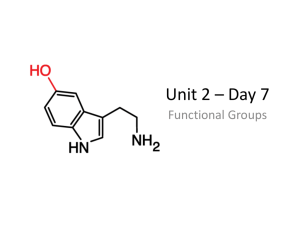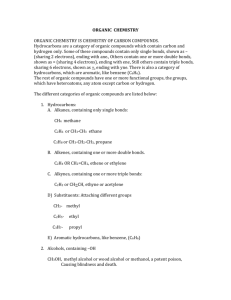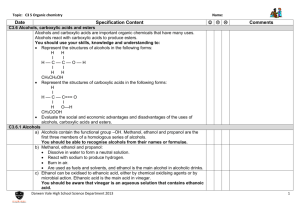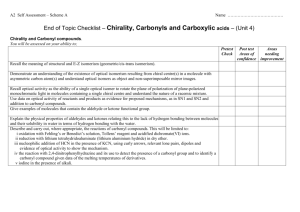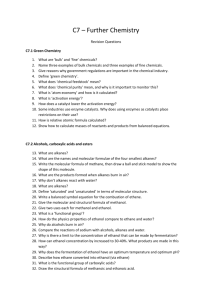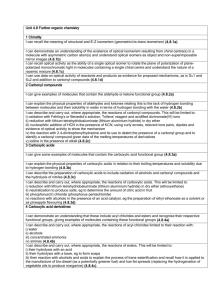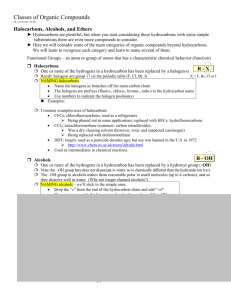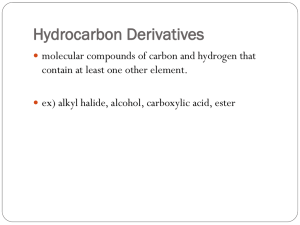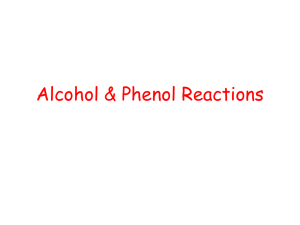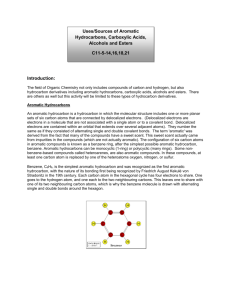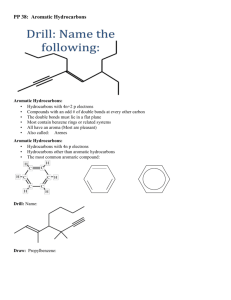Science 30 Chemistry
advertisement
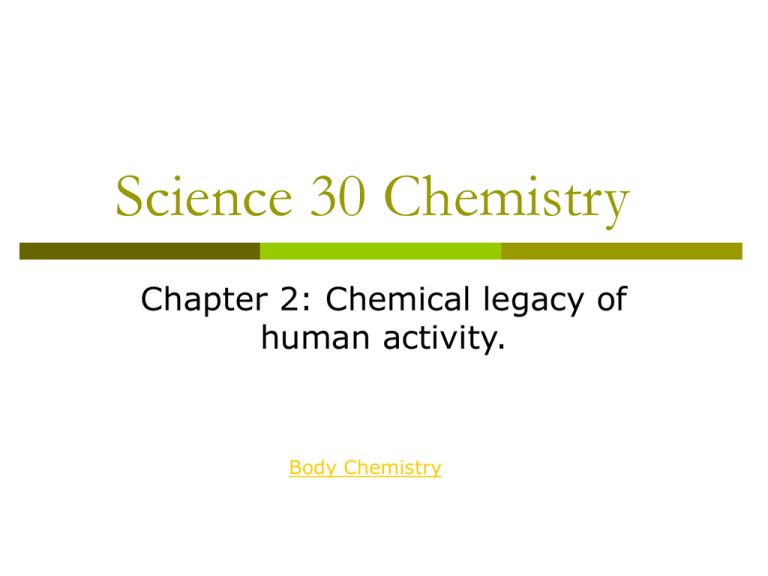
Science 30 Chemistry Chapter 2: Chemical legacy of human activity. Body Chemistry 2.1- Organic compounds 3 main types of organic compounds: Alkanes – single bonds, saturated. Alkenes- double bonds, unsaturated. General formula CnH2n+2 General formula CnH2n Alkynes- triple bonds, unsaturated. General formula CnH2n-2 Classifications of Hydrocarbons Hydrocarbons can be classified as follows: A) Naming system for Hydrocarbons 1. 2. Name the longest chain • for root of the word see Data Booklet pg 10 (meth, eth . . .) • Ending = ane, ene or yne Number the chain so branches are at the lowest possible position numbers. - If a double or triple bond, number closest to the bond. 3. Name the branches • Root of word same as above • Ending = yl Naming cont. 4. Put names together in this order: position #, branch, parent chain • Multiple branches? Put branches in alphabetical order. • Numbers are separated by commas. • Words and numbers are separated by dashes. • Multiples of the same kind of branch use a prefix to indicate how many (di, tri . . .). • Double or triple bonds must have the carbon # inserted and then the ending. Name the Following Hydrocarbons H H H H H H H H H C C C C C C C C H H H H H H H H H H C H H H C C C C C C C H H H H H H H CH = C-CH2-CH2-CH3 H B) Cyclic Hydrocarbons These are hydrocarbons that form rings; are also referred to as aromatic or phenyl rings. Are double bonded alkenes; general formula is CnHn Benzene is a hexagonal structure, all aromatic compounds are. naphthalene benzene Benzene Aromatics are naturally occurring, present in natural resources (coal and petroleum). Benzene is a carcinogen and the level in natural gas is regulated in Canada. When natural gas spills, the soil is contaminated with water soluble aromatics. Clean up must be completed through remediation (removal from groundwater, soil or surface water). 1) Remediation Involves the removal or breakdown of hydrocarbons in the gasoline. Harmful aromatics can contaminate drinking water, ground water and cause illness. Bacteria in soil naturally breakdown organics, but benzene is very stable and is not easily broken down. Because of the high stability, benzene is classified as a POP (persistent organic pollutant). Soil remediation Whyte Avenue soil remediation Bioremediation 2) Benzene structure and stability Benzene has properties similar to both alkanes and alkenes. Resonance is responsible for this: Stability- high stability similar to alkenes. Reactivity- high reactivity similar to alkanes. Within aromatic ring, electrons are shared by all carbons. Responsible for stability. High temperatures needed to break down benzene = contained in gasoline emissions. 3) PAH’s Polycyclic Aromatic hydrocarbons produced by incomplete combustion of oils. Found on charbroiled foods, smoke in forest fires and vehicle exhaust, Combine with DNA to form structures that result in mutations. Benzopyrene C) Functional groups In addition to hydrogen and carbon organic compounds can also contain other elements, often in specific arrangements. Functional Group: certain arrangement of atoms within a molecule determines properties of the molecule Molecules are classified based on functional group Example of a functional group Hydroxyl • functional group for alcohol • R – OH • NOTE: R represents any # of carbons Halogenated Hydrocarbons Functional group: One or more H is replaced by a halogen Halogens include: fluorine, chlorine, bromine, and iodine Naming Halogenated Hydrocarbons: Use a prefix to indicate the number of halogens Write chloro, fluoro, bromo, or iodo to indicate which halogen is present Name the parent chain Examples: trichloromethane tetrachloromethane CFCs Was used as a cleaner, found to be a carcinogen Damages ozone layer CFC’s (ChloroFluoroCarbons formed from carbon and halogens) are products common in air conditioners, aerosols, solvents and styrofoam packaging. These products make their way to the upper atmosphere and break ozone down. Cl + O3 = ClO + O2 ClO + O = Cl + O2 Ozone Layer A single chlorine atom removes about 100,000 ozone molecules before it is taken out of operation by other substances. Ozone The chemical formula for ozone is O3. It can be produced in the upper atmosphere when UV rays strike O2. O2 + UV -> O + O (1) O + O2 -> O3 (2) Ozone is also continually being broken down by UV rays. O3 + UV-> O2 + O (3) O + O3 -> O2 + O2 (4) A balance between these two reactions has resulted in a layer of ozone surrounding the planet. These reactions are responsible for absorption of 9799% of the sun's high frequency UV waves.. Ultraviolet light is light with wavelengths between 150 and 300nm UV-B radiation exposure causes increased cancer, eye cataracts, weakened immune system and reduced plant yields. "There has been a great deal of recent attention to the suspected increase in amphibian deformities. However, most reports have been anecdotal, and no experiment in the field under natural conditions had been performed previously," Even though the ozone is being destroyed naturally, it is disappearing faster than possible without other factors influencing it. The first global agreement to restrict CFCs came with the signing of the MONTREAL PROTOCOL in 1987 ultimately aiming to reduce them by half by the year 2000. The main CFCs will not be produced by any of the signing countries after the end of 1995, except for a limited amount for essential uses, such as for medical sprays. Other Halogenated Compounds Many other compounds cause damage to the environment: DDT – used for mosquito control Dioxin – byproduct of chlorinated processes Furan – byproduct of chlorinated processes 2.2) Alcohols, Carboxylic Acids and Esters 3 types of functional groups in organic compounds: Alcohols: OH group Carboxylic acids: COOH Esters: OH and COOH a) Alcohols Have hydroxyl in them (OH) and end in –ol. Hydroxyl group attracts water particles; causes antifreeze to slow freezing of gas lines. Uses and common examples: Solvents, fuels, disinfectants, pharmaceuticals. Methanol, ethanol, glycol and isopropanol. Alcohols contain Hydroxyl • • • Naming Alcohols: Omit ‘e’ at end of the name Change ending to ‘ol’ Properties: Hydroxyl group does not dissociate in water, therefore alcohols are NOT basic Liquid at room temp Distinct odour Examples: Methanol poisonous Ethanol in alcoholic beverages isopropanol Rubbing alcohol b) Carboxylic acids Carbon atom joined to a single oxygen atom and one oxygen joined to a hydrogen (COOH). Lactic acid is the name of a carboxylic acid produced during exercise; biphosphate is used to buffer it in the body. Carboxylic Acids Contain Carboxyl Groups Naming Carboxylic Acids: Properties: Omit ‘e’ at end of the name Change ending to ‘oic acid’ Weak acids because the OH donates a proton NOTE: the OH in carboxylic acids behaves differently than the OH in alcohols Examples: Vinegar Citric acid Lactic acid c) Esters Formed by carboxylic acids and alcohols reacting. Naturally occurring (fatty acids in bodies) and artificially (cosmetics/food industry). Water is a by product of the formation of an ester. Used to add a smell or color to a compound (e.g. Licorice). Esters Examples of esters: Cologne Aftershave pleasant odours / flavours in food Alcohols and carboxylic acids react to form esters An H is removed from the alcohol and an ‘OH’ from the acid- water is formed. Functional group for ester: Naming an ester: R’ is the alcohol, change the ending to ‘yl’ R is the acid – drop ‘ic acid’ and change ending to ‘ate’ d) Polyesters Polyester forms plastic: created by many alcohols and carboxylic acids reacting, forming long chains (polymers). These filaments are used to make many products: Towropes PFD straps T-shirts Wakeboards Dacron e) Bioplastics Plastics are not biodegradable; they do not breakdown in land fills (up to 300 years). Bioplastics are completely biodegradable but have the strength of plastics. Produced by tissues of plants or from bacteria cells. Water Pollution
